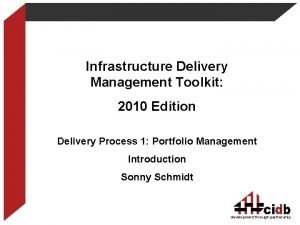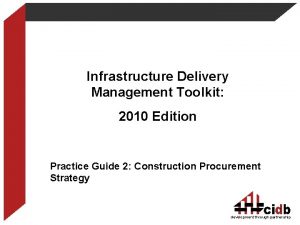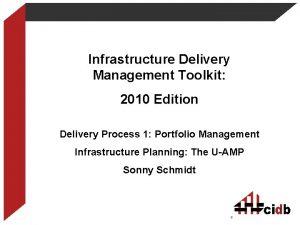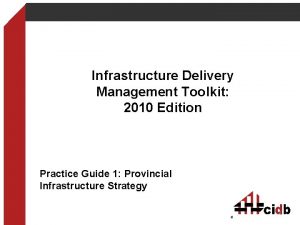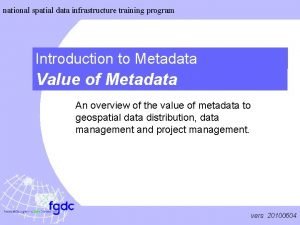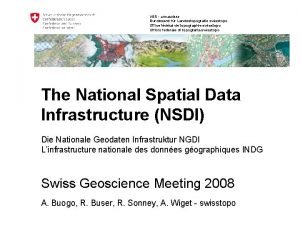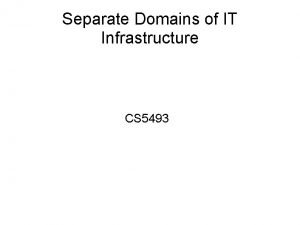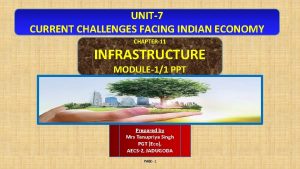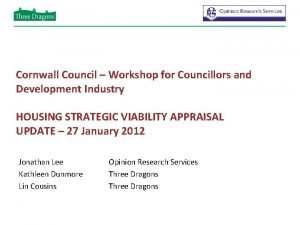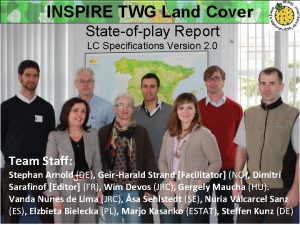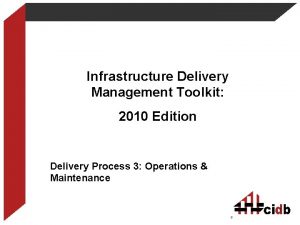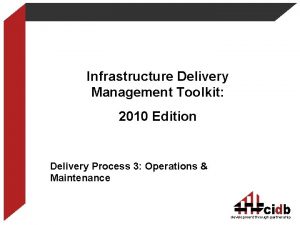DFR Presentation on Delivery of Infrastructure StateofPlay in












































- Slides: 44

DFR Presentation on Delivery of Infrastructure: State-of-Play in Ghana with Particular emphasis on Standards for Rural Transportation System By Ing. Dr. Kwasi Osafo Ampadu & Ing. R. O. Otoo (Department of Feeder Roads, MRH) 1

ORDER OF PRESENTATION Definitions 2. Specific Areas in the application of Standards in road construction 3. Types of Rural Roads 4. General Road Design Standards 1. 5. Ghana Standard Specifications 6. Trade and Investment Opportunities 7. Challenges 8. Conclusion 2

Definition of Standard Something set up and established by authority as a rule for the measure of quantity, weight, extent, value, or quality, etc. The definition tells us that there is the need for an institution to be set up to regulate and ensure that a product or service meets a certain minimum requirements. A standard is typically developed according to a specified set of rules and procedures providing consensus amongst many parties and is published by a neutral party. While standards have different purposes, they are mostly used as a reference for design or production. 3

Standards, Code and Specification-1 Standards are documents that establish physical, engineering or technical requirements for products, practices, methods or operations: It Builds confidence about quality among users It lowers the cost of production as requirements are standardize. Specification defines the standard and quality of materials and workmanship for a product or service. It is generally considered a working or business document. Ø Specifications provide additional requirements for materials, components or services above and beyond code or standard. 4

Standards, Code and Specification-2 A code is a standard that has been adopted by one or more governmental bodies and has the force of law, or when it has been incorporated into a business contract. A code Provides a set of rules that specify the minimum acceptable level of safety for manufactured, fabricated or constructed objects. A Code may also serve as generally accepted guidelines for design, construction and installation, if it has not been adopted as Law. 5

REASONS WHY Standards Are Required In the Construction of Rural Roads 1. 2. 3. 4. 5. 6. Safety issues Health issues Environmental issues Economy issues Aesthetic issues Professional ethics 6

1. Safety Issues Safety of passengers Safety of Pedestrians Safety of the vehicles Ø With line markings, warning signs, pedestrian crossings, speed humps, radius of vertical and horizontal curves, road widths, reflectors, traffic signs, roudabouts, road surface friction, etc. q THIS IS ENSURED DURING THE DESIGN AND EXECUTION OF THE WORKS, AND ALSO WITH CONSTANT MAINTENANCE WORKS. 7

2. Health Issues Condition of the road surface Riding Quality and number of speed humps NB: This very critical especially for the aged, the sick and the pregnant women. q THIS IS ENSURED DURING THE DESIGN AND EXECUTION OF THE WORKS, AND ALSO WITH CONSTANT MAINTENANCE WORKS. 8

3. Environmental Issues Pollution of water, air, flora (economic trees) and fauna Degradation of the natural soil, especially for farming Destruction of farms and properties Destruction of historical monuments, sacred grooves/shrines, tourists attractions, etc. q THIS IS ENSURED DURING THE DESIGN AND EXECUTION OF THE WORKS, AND CONSULTATIONS WITH THE PEOPLE OF THE AREA. 9

4. Economy Issues 1. To work to achieve project objectives: Cost Time Quantity Quality Must impact on the lives of the beneficiaries. Ø Mus try to use locally available materials as much as possible. Ø q THIS IS ENSURED DURING THE DESIGN AND EXECUTION OF THE WORKS, AND ALSO WITH CONSTANT MAINTENANCE WORKS. 10

5. Aesthetic Issues The attractiveness of the road must be pleasing to the eyes. q THIS IS ENSURED DURING THE DESIGN AND EXECUTION OF THE WORKS, AND ALSO WITH CONSTANT MAINTENANCE WORKS. 11

6. Ethical Issues Responsibility Share experience Protect Show honesty, fortitude, justice, etc. Uphold life, property, health, rights of individuals, etc. the prestige of the profession Conduct Conflict of interest, bribery, kick-backs, etc. Whistleblowing Report of a possible risk to the employer or the government promptly. 12

Types of Rural Roads 1. Technical Classification Engineered feeder roads are roads which have had comprehensive improvements throughout their length. Side drain ditches have been excavated, culverts have been installed wherever they are needed, low lying areas have been raised, the surface of the road has been compacted and shaped to a camber and a gravel or bituminous wearing course surface layer has been provided. Partially engineered feeder roads are roads on which some improvement has taken place, for instance some shaping of the road surface may have taken place and or a few culverts may have been added at critical points, but the road has not yet been brought up to the standard of an engineered feeder road. Un-engineered feeder roads are roads that exist in the form of footpaths or farm tracks which have not had any form of construction activity on them. 13

Types of Rural Roads (cont’d) 2. Functional Classification of Feeder Roads An Access feeder road is a feeder road that provides services to one or more communities but ends in a community without linking to any other road. An inter-district feeder road is a feeder road that connects one community in one district to another community in another district. A connector is a feeder road that connects one feeder road to another feeder road or 14

Types of Rural Roads (cont’d) 3. Surface Type An earth road is a road whose surface soil material is the same as that of the subgrade (see below). In this case the subgrade material may not be gravel or any type of soil which may be strong enough to withstand traffic load. A paved road is road that has its surface overlaid with a higher quality imported construction material as a finished layer to improve riding quality and durability. Examples are gravel roads, a bituminous surfaced roads and concrete paved roads. A gravel road is a road whose finished layer is made of gravel material. A bituminous surfaced road is a road whose finished layer is made of a thin layer of bitumen material. A concrete paved road is a road whose finished layer is made of concrete material. 15

An earth rural road 16

Unpaved Gravel-surfaced Rural Road 17

Concrete-paved Rural Road 18

Bituminous surfaced Rural Road with a pedestrian crossing 19

Bituminous surfaced Rural Road with rumble strips 20

Example of bridges constructed by DFR 21

Standards as applied in Construction of rural roads In the Construction Industry we substitute standards with specifications. Ideally, all specification documents would reference the applicable standard(s), so that any requirement is not taken out of context. Materials used for road construction; cement, sand, stones, iron rods, timber, natural soil, gravel bitumen, etc. are required to meet certain standards. Test methods used to measure the quality of constructed artefacts are published as Standards. 22

Design Standards and Specifications used by DFR Design Standards/guide: This defines the minimum requirement for the various elements of a road. Example of standards for a few road elements The Design speed for various classes of roads are stated in Design Standards, eg. Design speed for a feeder road is 60 km/hr, though vehicles speed more than that on the roads. Road cross-sectional elements for feeder roads Carriageway width (eg. 6 m for roads classified as access) Shoulder width ( 1. 5 m for connectors and inter-district roads, but no shoulders for access) Cross-section of a side ditch (V-drain top width of 1, 800 mm with a depth of 600 mm. 23

Road cross-section 24

Design Standards for Geometric Design Minimum curve radii Maximum super-elevation Sight distances 25

Design Standard for Horizontal Curves - Minimum Curve Radius Terrain GS BS GS Rolling BS GS Mountain BS Flat Speed Km/hr 60 80 50 60 30 30 e % 9 9 9 Connector Absolute f R (m) e % 0. 13 130 5 0. 13 230 5 0. 14 85 5 0. 13 130 5 0. 15 30 9 Desirable f R (m) 0. 08 0. 07 0. 08 0. 15 26 220 420 150 220 30 30

Superelevation ≈ Rv Fc α F cn F cp α W Ff e Wn 1 ft Ff Wp α 27

Design Standards for Geometric Design Minimum curve radii for horizontal curves 28

Horizontal Curve 29

Passing Sight Distance This is the distance required for a vehicle to safely and successfully pass another vehicle, typically on a two-lane road. Adequate horizontal and vertical passing sight distances are to be provided frequently for safety of road users. Roads that have very few sections meeting this requirement tries the patient of drivers and results in the dare devil ones making dangerous overtaking. Eg, Koforidua –Mamfe Road, Accra – Cape Coast Road 30

Design Standards for Vertical Alignment Design Minimum Curve length Maximum gradient Minimum stopping sight distance 31

Vertical Curve 32

Sag Vertical Curve 33

A rural road with vertical curves 34

Ghana Standard Specifications for Roads and Bridges (Ministry of Roads and Highways) General Scope This Specification defines the standard and quality of materials and workmanship to be used in the construction of roads and bridges in the Republic of Ghana. It is applicable for trunk, urban and feeder roads administered by the Ministry of Roads and Highways and its Agencies, namely: 1. Ghana Highway Authority (GHA) 2. Department of Urban Roads (DUR), and 3. Department of Feeder Roads (DFR). The Specifications should be read in conjunction with the Special Specification, which may amplify or modify this Standard Specification, as well as the Conditions of Contract, the Drawings and any other documents forming the Contract. 35

Specifications- Materials and Testing Cement The composition of Portland Cements (CEM I) shall comply with GS 22 or BS EN 197 and be sampled and tested in accordance with BS EN 196. Cements with more than 6% extender shall comply with GS 766 or BS EN 197. Aggregates Tests on stone, aggregate, sand filler shall be performed in accordance with the standard methods given in Table 2. 2. 36

Some Specifications FILLING MATERIAL ≥ 93% compaction SUBBASE 95 -98% -do- BASE 99 -100% -do- SUBGRADE (CBR) >15% 7 DAYS CONC. ≥ 10 N/MM 2 (PORTLAND CEMENT) 28 DAYS ≥ 25 N/MM 2 (size of chippings – 20 mm) SPREAD RATE 98 -100 M 2/M 3 (chippings) SPRAY RATE 1. 25 -1. 27 L/M 3 (bitumen) PRE-COATING RATE 12 L/M 2 PRE-COATING MIX 50% DIESEL+50% BITUMEN 37

Some Specifications (cont’d) Thickness of subbase material – 100 mm to 150 mm Thickness of base material Size of chippings for primerseal – 14 mm Size of chippings for final seal - 10 mm q NB: Soil materials of low California Bearing Ratio (CBR) are stabilized with quarry stones. – 150 mm to 200 mm 38

Slump Test TYPE OF CONSTRUCTION MAXIMUM (MM) MINIMUM (MM) All precast work 75 50 R. C. structures, blinding concrete 125 50 Mass concrete 100 25 39

Table 2. 2: Test Procedures Applicable to Stone and Aggregate Determination of Particle size distribution Clay, silt and dust in aggregate Flakiness Index Relative densitywater absorption Bulk density, voids and bulking Moisture content Aggregate Crushing Value Organic impurities in sands Los Angeles Abrasion Test Procedure BS EN 933 -1 BS 812 -103. 2 BS EN 933 -3 BS EN 1097 -6 BS EN 1097 -3 BS 812 -109 (Standard method – oven drying) BS 812 -110 AASHTO T 21 AASHTO T 96 (ASTM C 131) (coarse aggregate) ASTM C 535 (Large size coarse aggregate) AASHTO T 176 (Mechanical shaker or manual Sand equivalent shaker method) 10% Fines Aggregate Crushing BS 812 -111 40 Value

Trade and Investment Opportunities in delivery of rural road infrastructure in Ghana 1. Investment in improvement of roads leading to tourism destinations. 2. Investment in Construction of footbridges over water crossings across farm tracks and accesses to farming communities. 3. Investment in construction of major box culverts over rivers across roads leading to deprived communities. 4. Investment in bituminous surfacing of some rural roads Ghana using labour-intensive method in the near future. A pilot project is on-going in the Eastern region and is being funded by JICA. 5. Investment in improvement of rural gravel roads using labour-based technology to generate employment for the rural folk. 6. Funds for the payment of civil works in the construction of steel bridges over certain rivers. The metal components are already in stock for use. 41

Challenges 1. Delay in the payment of works done by the employer. 2. Inadequate contractors’ capacity. 3. Difficulty of contractors in accessing credit facility and also high cost of capital. 4. Contractors’ obsolete plants and equipment. 42

Conclusion Use of standards to design and construct rural roads cannot be over-emphasized. This is because life, health, safety and the environment are paramount. Of course, the agreed standards will also help to attain value for money. In fact, the use of Standards and Specifications are key in the delivery of infrastructure especially in the Rural Transportation Systems in Ghana. If standards and specifications are strictly adhered to, the benefits to the nation and the rural folk (about 60 -65% of the population) will be enormous. 43

End of Presentation Thank You 44
 Erl phase
Erl phase Tesla 4000 dfr
Tesla 4000 dfr Infrastructure delivery management system
Infrastructure delivery management system Infrastructure delivery management toolkit
Infrastructure delivery management toolkit Service delivery process definition
Service delivery process definition Infrastructure delivery management toolkit
Infrastructure delivery management toolkit Infrastructure delivery management system
Infrastructure delivery management system Infrastructure delivery management toolkit
Infrastructure delivery management toolkit Infrastructure delivery management system
Infrastructure delivery management system M.methodology/accenture.com/adm
M.methodology/accenture.com/adm Quality, cost delivery presentation
Quality, cost delivery presentation Smallest anteroposterior diameter of the pelvic inlet
Smallest anteroposterior diameter of the pelvic inlet 4 maneuvers of leopold
4 maneuvers of leopold Generic framework of electronic commerce
Generic framework of electronic commerce Tia 1005
Tia 1005 Software and its types
Software and its types Ramon lucio park
Ramon lucio park Centralized infrastructure
Centralized infrastructure Dcloud sd wan
Dcloud sd wan Openstack summit shanghai
Openstack summit shanghai Decibels
Decibels Nist framework for improving critical infrastructure
Nist framework for improving critical infrastructure Data infrastructure
Data infrastructure Logical infrastructure
Logical infrastructure Ad hoc vs infrastructure
Ad hoc vs infrastructure Intelligent infrastructure solutions
Intelligent infrastructure solutions Nisac
Nisac National spatial data infrastructure
National spatial data infrastructure Private wan infrastructure
Private wan infrastructure Advanced network infrastructure
Advanced network infrastructure Ip network infrastructure
Ip network infrastructure 7 it infrastructure domains
7 it infrastructure domains Man made disasters conclusion
Man made disasters conclusion Presidential infrastructure coordinating commission
Presidential infrastructure coordinating commission Logical network perimeter can
Logical network perimeter can Improving critical infrastructure cybersecurity
Improving critical infrastructure cybersecurity Grid security infrastructure
Grid security infrastructure Fbof controller
Fbof controller Three tier system of health infrastructure
Three tier system of health infrastructure Composable infrastructure definition
Composable infrastructure definition Data infrastructure
Data infrastructure Infrastructure failure definition
Infrastructure failure definition Community infrastructure levy cornwall
Community infrastructure levy cornwall Storage infrastructure management activities
Storage infrastructure management activities Hewlett packard converged infrastructure
Hewlett packard converged infrastructure


